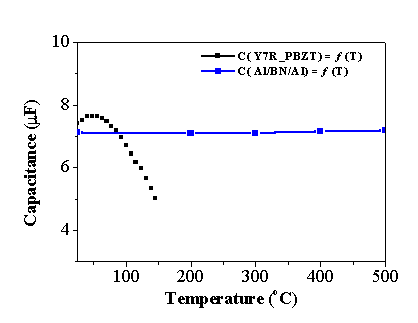BMDO Contract Number: DTRA01-99-0074
Investigators:
Prof. Abdelhak Bensaoula/ bens@jetson.uh.edu
Dr. Nacer Badi/ badi@orbit.svec.uh.edu
Nitride Materials and Devices Laboratory
Space Vacuum Epitaxy Center
Science and Research One, room #724
University of Houston
Houston, Texas, 77204-5507
UH Mail stop 5507
Voice: (713) 743-3621 ext 306
Fax: (713) 747-7724
Boron Nitride -based Multilayer
Ceramic Capacitors for
High Temperature Applications
Multilayer ceramic capacitors (MLCCs) are the most
reliable source for high-energy density storage banks.
They also find use in high frequency switch mode power
supplies. They have a large share in the capacitor market
with consumption in the 350 Billions/Year.
Existing MLCCs based on sintering are temperature
limited and use expensive precious metals (palladium
alloyed with silver) to avoid oxidation of the electrodes.
Other limiting factors are thickness control and
integrity of the dielectric layers as well as effective
electrodes.
Using In-situ deposition techniques, the Nitride group
at the University of Houston is making MLCCs as compact
electronic devices on silicon wafers, made from a stack
of thin BN dielectric layers in combination with
compatible low cost aluminum internal metals. We are at
the stage of low scale fabrication and optimization of
the A/d ratio in the capacitance design. This
will result in high energy density (> 5 MJ/m3)
at low voltage, higher volume efficiency, and
extended operating temperature range compared to leading
sintering oxide –based technologies (see caption
below). The BN –based MLCC match well the SiC
technology > 300 oC and can be integrated
into existed and future MEMS systems as compact power
sources. For more detail please refer to the abbreviated Phase I Report

Thermal characteristics of BN
and Y7R-PBZT -based multilayer ceramic*
* For a comparative purpose, capacitance value
-3.25 m F- of BN -based capacitor is normalized
to 6.8 m F
|
